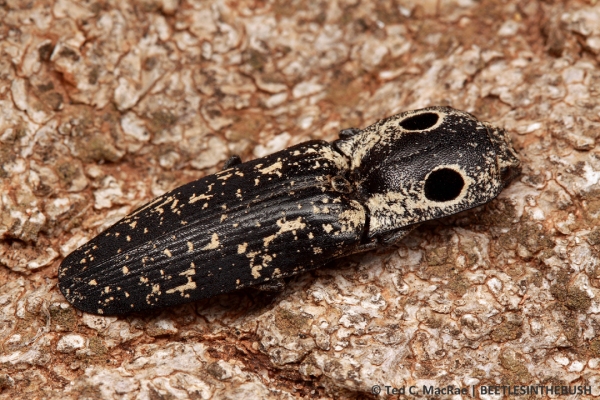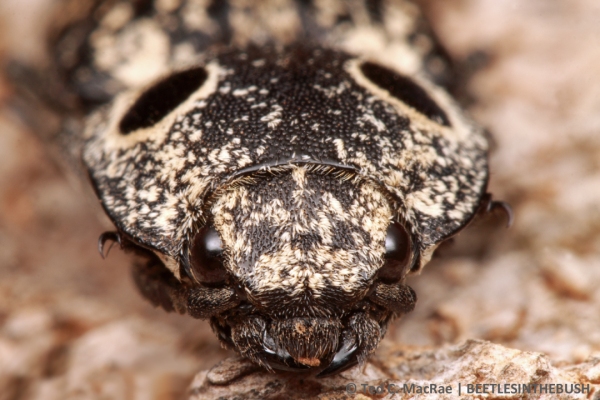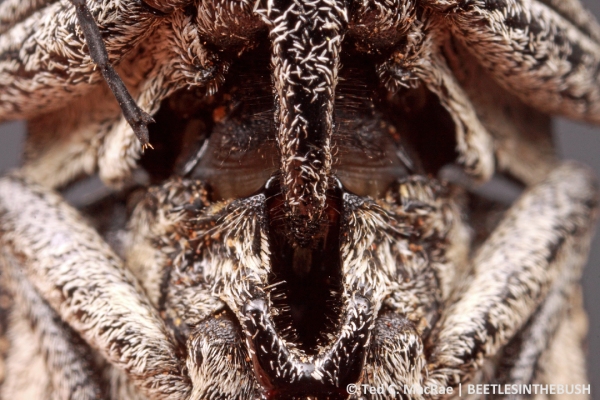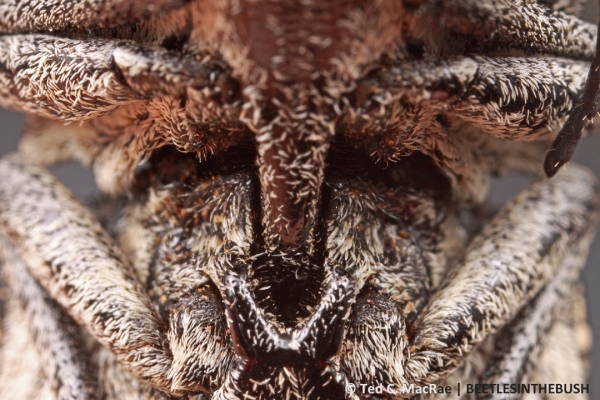
Alaus oculatus (eyed elater) | Beaver Dunes State Park, Oklahoma
Last June while collecting beetles from cottonwood trees at Beaver Dunes State Park, Oklahoma, I came across one of my favorite beetles—Alaus oculatus, or eyed elater (family Elateridae, or click beetles). Large by click beetle standards, the most striking feature of eyed elaters is, of course, their false eye spots, which are not eyes at all but patches of pubescence—black surrounded by a narrow ring of white—intended to look like eyes and located prominently on the prothorax rather than the head. A handful of related species are also found in various parts of the U.S., all of which exhibit variations on this same eye spot theme. Undoubtedly these spots serve to frighten would-be predators, much like the false eye spots on the thorax of many lepidopteran caterpillars. The true eyes, of course, are much smaller and are located on the head in front of the “false eyes.” In contrast to the prominently visible eye spots, pubescence on the rest of the body seems to function in cryptic coloration. The mottled patterning blends in with the bark of trees where these beetles usually hang out for effective concealment.

Look into my eye(spot)s!
If either of those first two lines of defense don’t work, the beetles exhibit “thanatosis” by lying still with legs and antennae appressed to the body to fool the would-be predator into thinking that they are already dead.

Adults exhibit “thanatosis” (play dead) when disturbed.
Their most remarkable defensive behavior, however, is their ability to snap or “click” their bodies with enough force to free themselves from the grasp of a novice predator (or careless entomologist). The click is produced by a large prosternal spine and mesosternal notch on the beetle’s underside. To click, the beetle arches back its head and pronotum to retract the spine from the notch cavity, the tip of which is then pressed against the edge of the notch. Muscles within the thorax contract, storing elastic energy, and as the flexible hinge between the pro- and mesothoraces moves, the spine slides until its tip passes over the edge of the notch, releasing the elastic energy stored in the thoracic musculature and snapping the spine back into the notch cavity with enough force to produce an audible click.

A large spine on the prosternum fits into a groove on the mesosternum.
This clicking ability also comes in handy if the beetle frees itself from the grasp of a predator and lands on its back. While the beetle’s legs are too short to right itself, its click is capable of launching the beetle high into the air. By tumbling while in the air, the beetle has a 50% chance of landing on its feet (thus, several attempts may be required). When jumping from a hard surface, the beetle is actually capable of launching itself to a height that is several times its body length and can tumble several times while in the air. This raises an interesting question, since theoretically an elevation of only one body length and half of a body revolution are all that is needed for an upside-down beetle to right itself. The power of the click, thus, grossly exceeds the minimal requirement for righting, yet the beetles seem incapable of moderating the force of the click. Furthermore, the 50% probability of landing suggests that they are also incapable of controlling the orientation of their body during the jump and landing. Did the clicking mechanism initially evolve to combat the grasp of predators and was then co-opted for use in jumping, or was the ability to jump the selective pressure that drove its evolution?

Locked and loaded—the mechanism is primed for the click.
Ribak & Weihs (2011) used biomechanical analyses with Lanelater judaicus to support the idea that the click evolved primarily as a mechanism for vertical jumping. They reason that the excessive vertical distance of the jumps ensures sufficient height when jumping from soft substrates such as foliage or loose soil. A followup study evaluating the effect of natural substrates (Ribak et al. 2012) found that jump height was dramatically reduced (by ~75%) when the beetles jumped from leaves that covered approximately half of the study site and that the reduction in jump height was directly correlated with the amount of work absorbed by the substrate. This provides further evidence that the beetles do not moderate their jumping force and instead simply aim to jump “as high as possible” and rely on random chance for landing back on their feet.

After clicking, the spine returns to its resting position within the groove.
REFERENCE:
Ribak, G., S. Reingold & D. Weihs. 2012. The effect of natural substrates on jump height in click-beetles. Functional Ecology 26(2):493–499 [abstract].
Ribak, G. & D. Weihs. 2011. Jumping without using legs: The jump of the click-beetles (Elateridae) is morphologically constrained. PLoS ONE 6(6):e20871. doi:10.1371/journal.pone.0020871 [full text].
Copyright © Ted C. MacRae 2014
Excellent explanation and photos of the click mechanism; thank you for posting this article. The only statement that made me blink was about the eyespots being “intended to look like eyes.” Whose intention? (Shorthand, of course, that we all understand.)
Alaus oculatus is called common in the guidebooks, but that is not my experience. In 30 years of general collecting in the eastern US (mostly Connecticut) I’ve encountered 4, versus hundreds of each of several small, nondescript elaterid species.
I don’t see them that often either, although a little more frequently than you. I do see the more southern, pine-associated species, Alaus myops rather consistently at blacklights in the pine forests of southern Missouri.
My favorite eyespots are on the Io Moth, which mimic eye shine.
We used to place bar bets on whether Pyrophorus click beetles would land upright after a click, and it was always about a 50/50 chance. Jump height was usually about 4 in. Pyrophorus are very common down here (Miami) in May, but I never find them any other time.
Experimental confirmation of the 50% probability of upright landing! 🙂
Yes, nice to have such a full explanation of the phenomenon and the significance of the clicking and jumping. A little thing made me blink, too, the use of the word “undoubtedly” in the same part of the essay. There are those who say we should not use that word in science writing, however likely something seems. Anyway, I then went on to read a nice bit of natural history, so not complaining.
I’m still not convinced that escaping predator grasp did not play a significant part in selection of this trait.
It is alarming to have one click in your fingers.
Thank you for this! I work in bioacoustics, but with vertebrates, so I have always wondered how they click — I’ve never found the time to look into it. I find these guys so fascinating (and cute!). Great images (as always) of the spine – they made my morning. I think I may be more of a dork than I realized.
I didn’t know either before I took these photos and then deliberately set to finding out. Surprisingly, while I found many references that simply said the spine locked in place, it was rather hard to find references with any real detail about the locking mechanism.
Regarding my use of terms such as ‘intended to’ and ‘ undoubtedly,’ it is clear to me now that I should have studied up on the rules for How to write consistently boring scientific literature before I wrote this post. Use of flowery language was not my only violation—so were my uses of humor (“careless entomologist”), personality (“one of my favorite beetles”), and illustrations (particularly good ones). Worse yet, I didn’t cite my own work even once. 🙂
No no no! Keep doing what you’re doing, please! (Undoubtedly, your comments just now were intended to provoke such a response, and I’m happy to give it 🙂 )
Well, alright—if you insist 🙂
Pingback: Mechanical Design of Popping Beetles | Ilya's Life Weblog
Pingback: Entomology Word of the Week | Wannabe Entomologist
Great series and article, Ted! That is an especially nice face shot on a click beetle.
Pingback: Go away or I will glow at you | 6legs2many
I have come across a few beetles that can snap here in Norway. Im astonished about the power output of the click. Its head is far smaller than the rest of the body and clicking the head it can probably toss itself up to 25 cm into the air. Having a head the size of 5 or 6 mm that has to produce an incredible force to the shell. To jump it tilts the head backwards lifting the back part closest to the neck up from the ground and when snapping it slams the shell into the ground or surface bounching the beetle into the air becaouse of the impact. So far ive only noticed that they use it to try to get on their feet. But probably also a good way to get away from ants or other small annoying creatures. Bug eating mice or rats would have no problem catching it again after a jump so not much help against rodents. I also think they contract their limbs to prevent damage them as most living creatures does as a defence when they know they will get hit by something hard. It would be interesting to see this with a slow motion camera. Does the limbs start to move mid air or after it has landed? But probably hard to focus on the beetle snapping out of the picture.
PS! Pardon my grammar.
Hi Henrick, thanks for your observations. I’m fairly certain that the beetle holds the legs tight against the body during the jump, as I’ve noted that when they land upright it takes a split second for them to realize this before they then extend their legs and start running. The habit of playing dead with the legs held up against the body is called ‘thanatosis’.